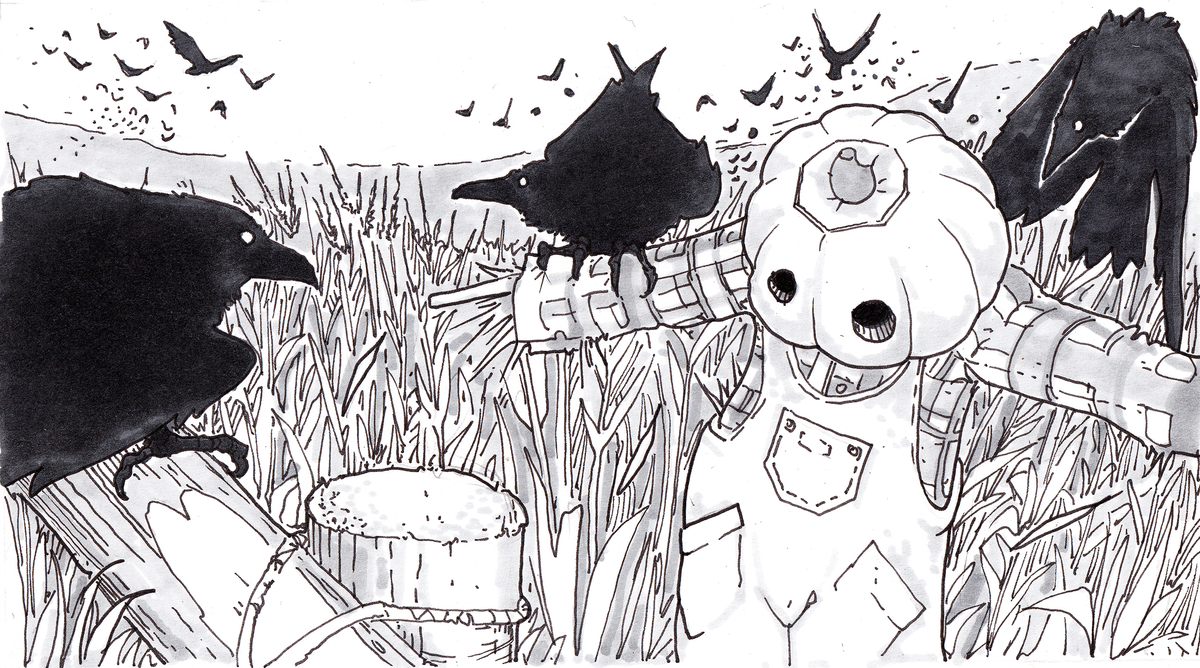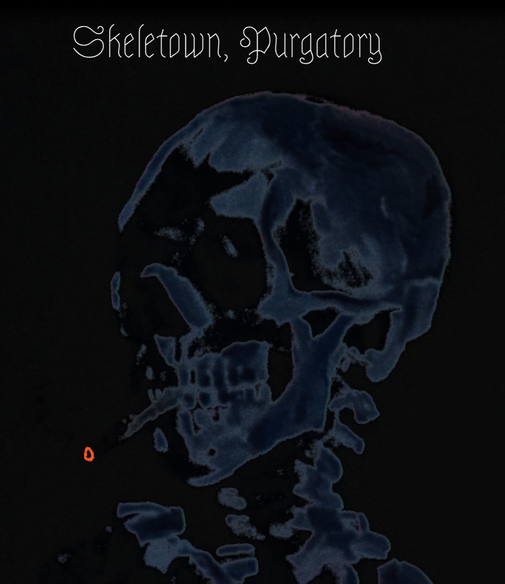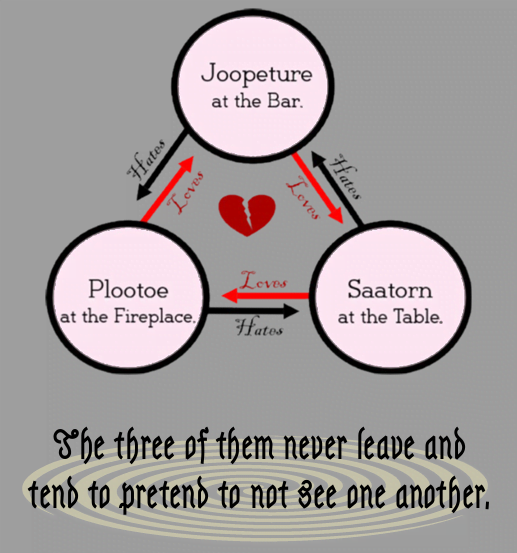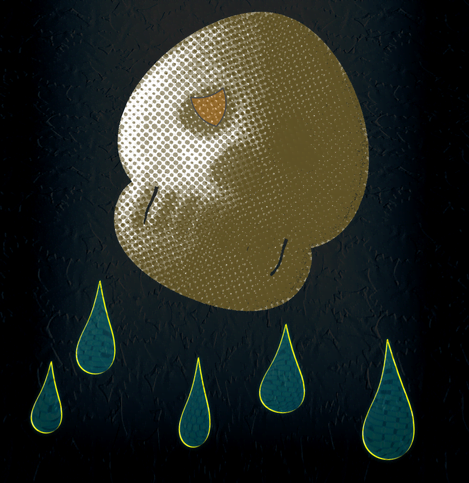September 2025 - Fallow

The Carousing Collective has had a busy end of summer. Some of us have submitted to recent game jams, others have been on vacation, and a few have written hefty blog posts. This month's issue is a bit sparser than usual. We've let our fields lie fallow, but you can expect a bountiful harvest in OSR October!
Roll to Carouse!
- Lighten your coin purse at the Projects Pavilion.
- Pilfer ideas from the Blog Bazaar.
- Sample the delights of the Gameable Gallery.
- Hear the raving of Reviewers Row.
- Stroll the Columnists Colonnade.
- Languish in the Opinion Oubliette.
Projects Pavilion ⤴
The Mouth of Mormo by Arnold K.
Not only is this a free twenty-room dungeon, the jumbo version is basically a thesis on refereeing a dungeon crawl with extensive commentary on design, making rulings, and running rooms. This is a comprehensive resource that I imagine OSR referees will keep returning to for years to come. - Rowan
Minimalist TTRPG Jam 4 by Binary Star Games
Another round of this pared-down jam is up and running until October 31st. The focus is on games that are minimal in a visual sense, with an aim at getting writers and designers to just Go For It rather than stress about a presentable product. If you've got a lot of ideas swirling around in the brainstem but haven't had an excuse to spit them out, now's your chance 🫡 - Taylor B.
Blog Bandwagon: Appendicitis N by Prismatic Wasteland
Warren Prismatic Wasteland of Prismatic Wasteland fame has sounded the call for a new Blog Bandwagon - this time, the theme is Appendix You! What media inspires you? How has it influenced your work? If you've got a blog, now's your chance to write something real self-indulgent. Don't have a blog? Start one! Bearblog's a great place to get set up. The deadline is September 8th, and there's always a big roundup post of all the entrants once everything's said and done. I hope to see your post there! - Taylor B.
The Spear That Cannot Cut Through Water by Bommyknocker Press
A submission to the first Mythic Bastionjam by fellow Carouser Zak! Rather than a more typical Myth, this provides a small adventure site and faction conflict meant to add some depth of flavor to your realm. I'm especially drawn to the shining Palace of Fountains and its dense, Piranesi-like statuary vignettes. Check it out! - Taylor B.
Flood and Flora by Barse and Giant Robot Tackler
The Mythic Bastionland Jam just concluded, and some wonderful writing came out of it. The best entries capture the tightly-wound terseness of the original game. The very best retain an ambiguity at their core, leave just enough unsaid that players and refs can breath life into them at the table. Flood and Flora hits these marks, and is beautifully illustrated to boot. Thorned roses and hooked worms abound in these two Knights and Myths by Barse and Giantrobottackler (our own Taylor B.). - Zak H.

Blog Bazaar ⤴
The Combat Conundrum by Forest Oath
Evangeline thoroughly analyzes her gripes with Mothership’s combat system. - Tobias
Sicko Worldbuilding by Mindstorm
Ty writes about the difference between being a tourist and being the local tourists depend on for the good stuff in your fantasy worlds. The use of personal anecdote is charming, but also really effective at proving his point before hes even made it. A banger of a post. - Farmer Gadda
Why Religion Feels So Fake by ReligionForBreakfast
Religion in games and settings always makes me want to roll eyes. They feel like checklists and clichés rather than something that people actually do believe in. ReligionForBreakfast picks this up and shows us 4 things that can help you to depict a religion or belief system more grounded and real. - elmcat
Gameable Gallery ⤴
d66 Commandments
by Rowan H
Mandates, tenets, and decrees for fictional religions, cults, and societies.
Thou Shalt Not...
11. Consume the egg of a flightless bird.
12. Speak the name of a torturer.
13. Exeunt through a window.
14. Sheathe a blade unbloodied.
15. Drive an animal through rain or snow.
16. Poison bread, wine, cheese, or cured meats.
21. Disturb mirror-smooth water.
22. Display humility while accounting thy deeds.
23. Cast aside that which you have not attempted to repair.
24. Refuse a polite request from a cat.
25. Carry water in the skin of an animal.
26. Cooperate with a sheriff bailiff, or barrister.
31. Deceive a child.
32. Sever rope, thread, yarn, spiderwebs, or the like.
33. Spend more than a fortnight at sea.
34. Haggle with an artisan.
35. Use wood from a fruit-bearing tree in carpentry.
36. Sell, gift, or abandon thy steed.
41. Wear jewelry, ornaments, or fine garments.
42. Reveal a secret without compensation.
43. Deny a swift death to the mortally wounded.
44. Accept a gift from a peasant.
45. Destroy or deface writing.
46. Travel with the sun at thy back.
51. Pay a tax, toll, levy, tariff, or fine.
52. Steal from an empty dwelling.
53. Commit thy name to parchment.
54. Extinguish a flame.
55. Strike the first blow.
56. Hinder the progression of a disease.
61. Expose bare skin to moonlight.
62. Allow a lie to go unchallenged.
63. Fell a tree bearing a nest.
64. Show mercy to a slaver.
65. Partake in games of chance.
66. Meddle in the affairs of lizards.
The Herb Garden
by Patchwork Paladin
Store Type: Provisioner
Location: Upper Colonnade
Pleasant and sweet smells surround you as you enter this stall. Herbs dry near the ceiling at the back, and jars and waxcloth packets of a range of plants are stacked neatly against the wall.
In the back, a rotund halfling sits with several pipes close at hand that give off a smoky herbal smell. This is Thaddeus Thoroughgood, the proprietor of "The Deep Market's only real herbalist shop," as he'll happily tell you. Thaddeus is dressed in blue plaid knickerbockers with braces and a ruffled white shirt. Thaddeus has smoked far too much hemp in his life to really be concerned about much, but he is afraid of his gardening sister who prepares the stock and dare not sell anything at a lower price.
The shop has:
- ordinary dried cooking herbs - mint, anise, willowgrass, chervil and so forth,
- medicinal herbs to refill a healer's kit - willowbark, yarrow, dried balm, dock root,
- repellent herbs for various noisome insects and other vermin,
- herbs for relaxation - tobacco, hemp, mallow, sage,
- herbs for dyeing - woad, madder, weld,
- herbs for drinking - chamomile, verveine, and camellia,
Lectures are given alternate Thursdays on proper propagation and cultivation of herbs, and the Women's Herb Collective meets on the first Wednesday of each month.
Adventure Hooks
- Bad weed - some of Thaddeus's hemp is causing customers to have unusual side effects, such as blue spots appearing on their face and uncontrollable burping. While hilarious, these quickly progress to more serious illness. Can the party find out what's causing it before it's too late?
- Thaddeus's sister Rosamurta is sure that one of the women in the Herb Collective is trying to poison her. She wants the party to attend the Herb Collective meeting undercover and watch the suspect closely.
- The man from two stalls down is pressuring Thaddeus to obtain an herb he knows is poisonous. Can the party make him stop please? Thaddeus will give them a very special healing herb if they do.
- Thaddeus is being besieged by competitors for the Great Market Cook Off competition because his herbs are the freshest and best. The competitors have cleared him out of cooking herbs and he needs someone to head to the River Gate to fetch some of his stores. It's quite safe. Really.
Wellenbrecher
by Tobias Adam
Enchanted longsword made of blue-hued steel. Engraved magic circles and runes in the blade enable it to cut any fluid.
When the blade is stuck into the ground of a body of fluid, the fluid gets pushed back and a patch of dry space is generated, depending on its state. Still fluid: a 5ft. radius circle around the blade. Moving fluid: a 15ft. cone behind it. The patch of dry space exists as long as the blade remains in the ground and refills in a matter of seconds, once pulled out.
Creatures made from fluids (such as water elementals) are cut clean and instantly killed when struck by the blade.
Reviewers Row ⤴
Trespasser
by Sprinting Owl
In April this year, Spectralidax published IRON SLEET. An animist mercenary fantasy, it jammed itself crablike into a niche between Metal Gear and Arknights and cemented its place there with gorgeous art, clean layout, and a snappy grid based tactics lite approach to gameplay.
Now, five months later, a second SLEETlike has hit the scene. And it’s fantastic.
Trespasser by Doom Captain and Polilla is intimidating in its polish. And twice that for its development speed. If Trespasser began development after IRON SLEET’s release, it took at most five months.
It is admittedly easier to build on a foundation than it is to build the foundation itself, and Spectralidax’s rules writing is a fantastic foundation on which to build, but Trespasser is ninety pages. It is packed with Polilla’s full page, full color art. It is constantly creative with its layout, using complex background elements and tilting its text boxes to give the impression that it has been imperfectly scanned from secret documents. This was an enormous undertaking, done at speed by a small team.
So, what is it like?
Trespasser’s setting is presented in bursts of evocative information. Corte Largo is a post apocalyptic valley under military interdiction. A giant satellite laser watches it from the sky. Trespassers poke through it, supervised by their handlers. Other forces, their true objectives unclear, seek to punish the Trespassers for their meddling.
There’s a little Roadside Picnic, and there’s a hefty double dash of Girls Frontline, but even more so than in IRON SLEET, Trespasser breaks away from its inspirations to tell a story that is uniquely its own. It hints at agencies grappling with each other in a struggle aided by supernatural forces. Its writing is economical but it covers a lot of ground with what it says. It loves to give the reader implications more than facts. It doesn’t want to be skimmed, it wants to be dug into.
Trespasser’s itchio page describes it as a setting more than a game, but it is standalone and rules complete. You don’t need IRON SLEET to play it. You do need the same things you’d use to play IRON SLEET---a d20, some d6s, a GM, and friends.
Mechanically, Trespasser and IRON SLEET both sit somewhere in between traditional and osr. You roll a d20 vs a TN and add or subtract d6s based on external circumstances. Characters can take multiple actions in a turn, and have a stat for that. Damage adds up first as wounds, then rolls on a table for injuries, then kills you. There’s a reroll currency called Fate. And while simple, the equipment weight system matters.
Combat is brisk but meaty, with a lot of different action types, equipment choices, kinds of injury, player abilities, and other bits of data enshrined by the system. They’re all simple to read and process, but they give the game a backbone that isn’t just the referee’s adjudication.
Character creation is point buy, with a very loose class choice at the beginning that shapes how you see the world. Notably, a lot of the choices rotate around themes of alienation, depersonalization, and the attempted or successful breaking of your will. Folks who like mechsploitation, there’s something for you here.
For folks who like getting tacticool, there is extremely something for you here as well. The equipment list runs fifteen pages and includes different types of radio packs, occult trinkets, and the option to modify your firearms. Weapons are presented mostly by general category---so “flamethrower” instead of “Type 74”---but there’s multiple pages of those categories to choose from. Like with the character abilities picklist, this is the kind of rpg chapter that you can really sink into. And there’s an optional mission budgets rule later in the GM’s section that encourages groups to switch up their standard kits, incentivizing experimenting with other styles of play.
In terms of overall GM support, the section at the back of the book is robust and includes a bestiary, but as I said earlier this is a book that wants to be dug into. The lore is important to the game, and you have to read it closely and reach your own conclusions about certain things in the lore. You have some signposts to work from, but ultimately you have to decide what Trespasser’s world looks like to you.
So, who do I recommend Trespasser to?
Well, top of the list is anyone who liked IRON SLEET, or who likes the loose intersection between military industrial aesthetic and fantastical elements. More specifically, though, groups who are looking for a medium length campaign, a tactical oneshot, or a far future valley to be depressed in will have an excellent time. A lot of what Trespasser is, is the juxtaposition of beauty and loss, freedom and isolation---but it can be run a bit cheerier too. There is room in its boundaries to tell stories of warmth, collective struggle, and friendship. As specific a type of thing as Trespasser is, it is very approachable too.
And this, I think, is the real triumph of the SLEETlike (a subgenre that now consists of two games.) It’s easy to pick up. It’s engaging. The phrase “DnD killer” gets bandied around a lot, but for the right group this absolutely is one. Let Trespasser hunt down and tactically eliminate your 5e corebook. And then go grab a copy.
Because we cannot count on another incredible SLEETlike coming out in the next five months.
Two bangers is a miracle.
Three would be absurd.
Don't Fade Out: A review of Skeletown, Purgatory
by Taylor B.
Background

"Where does god put the faithful who erred only by loving life too dearly?
Why in a void, a hole, a cave,
A puppet stage,
Wherein skeletons pantomime
Their forgotten lives
Suffering a slapstick facsimile
unending."
Skeletown, Purgatory is an adventure by Evey Lockhart, written as part of her Sisters of Moonlight Remembered setting for Simple DeeEnDee, although it's easily playable with any OSR system. I first heard of Evey through her prolific Troika! catalogue (specifically Wet Grandpa), but this is my first time digging into her other work.
I'm not familiar with Simple DeeEnDee or her Sisters setting, but I picked up Skeletown anyway just from how struck I was by the premise. The adventure presents itself as "one of the infinities of pocket prisons that make up the languishing land of Purgatory", full of skeletons play acting their old lives in denial of their own deaths. This checks a lot of boxes for me (a sicko), calling up Calvino's city of Eusapia, Lilith Zone's haunted worlds, Cruelty Squad's desensitized numbness and stagnation. Turns out the key to my heart is just taking a skeleton and putting them in a kind of fucked up situation. Who knew!
What's inside?
Skeletons, baby. You get a few pages of very basic setup (the party's stuck in purgatory! how do they escape?), but the bulk of the page count is spent on keying the town. Across 33 pages, we see:
- a skeleton grocer diligently eyeing her empty shelves
- multiple three-way love affairs (one fruitful, one unresolved)
- a mansion under constant construction by useless skeletons with useless wealth
- glass blowers focused so intensely, for so long, that they've forgotten their own names
- a museum-display golem with a zealot's holy fire
A summary doesn't do it justice - Evey's prose casts a comically pathetic light across the town. The skeletons are clumsy, slapstick, given to silly names and pointless routine. They fully believe they're alive and fly into incoherent rage at the sight of real flesh and blood. Still, there's melancholy. Time has flattened them: the surgeon has nothing to heal, the grocer has nothing to sell, families are right down the road but eternally separate. The only resident to realize they're in Purgatory has spent the last 600 years in an unending funk.

The word of the day is stasis. This isn't a powder keg ready to blow, it's an obituary. There's plenty of relationships but no real Situations. Nothing feels resolveable. You get the feeling that even if you help these people out, they'll be right back where they started in a hundred years. It's horrible!! In a good way!!!
The page count doesn't tell the full story, also. Each keyed page contains the full (generously hyperlinked!) map, with the space left over only good for one or two keys. As someone who mostly runs games digitally, I dig it. You're always one click away from the room you need to see, which alleviates the typical round of PDF panic-scrolling I always seem to encounter. Buuuut as someone who occasionally runs games in person and has a deep hatred for my printer... I still dig it. But I might pick something else for that game 😬.

What do I think?
Well vibes-wise it's exactly my shit but tbh on first read I wasn't sure how I'd run this. Mainly within all those keys only two (27 and 32) reasonably point to the exit in area 31; the rest is atmospheric skeleton scenery with little tension or movement. The town is 90% bone vignettes by volume. Per Evey's socials, in the Sisters of Moonlight setting you are forever moving through an endless number of heavenly dungeons (killer concept btw), so the goal is always to survive and find the exit. In that context, the sparse clues make more sense as this is more of an investigative adventure, but as written it feels directionless still.
The main threat comes from the fact that the skeletons attack indiscriminately if they see you're a living human, but what happens when you deal with that? I'd expect a lot of playtime might be spent trying to get these fuckin skeletons out of their ruts (or passively observing from a distance) only for them to not know or care about the exit at all. I also wouldn't be surprised if that was the point! That sense of frustration would align with the listless drudgery of the setting.

If I'm being honest, if I'm being REALLY honest, I think I'd prefer this in a medium that's not a TTRPG. The stillness here makes the NPCs feel very video game-y to me, like little two-line one-off characters in an RPG town just repeating their shit over and over. Actually while reading my mind kept going back to Lilith Zone's first-person RPG Maker game Day/Night Town and how much I adored exploring that strange, static space; the magic in that. Transplanting to a video game would drastically reduce your ability to meaningfully interact with the world. Does that serve Skeletown's themes better? Idk, but it's fun to imagine.
If this line of thinking tells you anything, let it say that the feelings Skeletown evokes are misty and potent, and I would fight hard in any runthrough of the module to do those feelings justice.
Flavor Packet: 1d6 Living failures in a dead world
This is part of my ongoing initiative to show how, in our shared hobby, reading a work goes hand in hand with being inspired by it. My first thought was a set of hooks that add some time pressure or stakes, but that wouldn't fit the heart of the adventure. I ended up going with a series of other living folks who've been sucked in too deep and are just as stuck as the skeletons. Enjoy!
- Ayo Three, ship captain. Obsessed with resolving the Triangle Tavern love triangle. Thinks they should all just make out and get it over with. Lives out in the woods in a tent filled with copious, increasingly angry notes on the lovers.
- Billy Caverns, philosopher. Believes the skeletons in their repetition have unknowingly achieved enlightenment. Starves himself thin and paints his skin white with bone meal paste. Spends all day sweeping the same two leaves by the town entrance.
- Rita van der Beek, author. Thinks her written history of Skeletown will fix everything. "I can't leave until it's finished." Pulls a wagon with 58 volumes of documentation, identical in all respects save the number on the front.
- The Undertaker. His name slips in one ear and out the other. Sits on the edge of town in a smiling bone mask next to a shovel and a cup of black tar coffee. "They're still moving. I'll wait."
- Sligo Katz, nervous wanderer. Naturally pale and frail enough to pass as a skeleton. Got a job as a glass blower via farcical series of accidents. Won't leave for fear of disappointing a boss who does not even remember his name.
- Wes and Cal, priests. Observe the town with telescopes from a distance. Always arguing whether Skeletown's existence is a product of God's love (Wes) or hate (Cal). Each believes the other does not reciprocate his feelings.
Final Thoughts
Good shit. I hope Evey runs a game jam for the Sisters of Moonlight Remembered setting because I'd love an excuse to write for it. I rate Skeletown, Purgatory one futile infinity out of another. You can purchase it here.

Columnists Colonnade ⤴

Dear Diem
Relationship Advice for People who Roll Dice
by Carp A. Diem
A wonderful day to you, dear readers! The summer sun has set for the last time this year, and I find myself basking in the glow of it's dog days, anticipating the oncoming nip of the autumn breeze. Luckily for me, I have these letters sent to me by readers like you to keep me company! I shall endeavor to offer helpful advice, as I have with the passing of every season thus far.
Dear Diem,
My table and I had a discussion about our gaming 'bucket lists' the other day. It became quickly apparent that even if we were to dedicate a weekly gaming session, we may never fulfill all of our desires. There are just too many games and too little time to play them. How do you decide what titles to give your attention to?
Yours Truly,
Indecisive in Indianapolis
Dear Indecisive,
Instead of worrying about 'getting to' all of the wonderful games that are out there, I find there's comfort to be found in accepting that games aren't something one can ever completely experience. Life is short, and there will always be a new game, campaign idea, or table that is just out of reach. Rushing to a finish line isn't what tabletop rpgs are about! It's okay to take your time, savor what's in front of you, and live in the moments you get while pretending to be an elf with your friends.
But -playing- a game isn't the only way to appreciate it! Simply reading a game and imagining how a session of it would turn out is as valid an experience as getting it to a table. Collecting books or enjoying actual play recordings is a quick way to engage with the artwork without needing to schedule a whole event around it. Find the method that works for you and your lifestyle, and indulge to your heart's content.
...Oh no, I've just provided multiple options to you when you were already indecisive. Shit.
Decisively Yours,
Diem
Dear Diem,
My DM is pretty new to the game, and told us that in preperation, they'd consumed as much of the original D&D Appendix N as possible. Unfortunately now, we're 5 sessions in, and nothing we've done feels like it's remotely in the spirit of Gary Gygax. When our DM was in the bathroom, we checked their Ipad and found that they'd mislabeled a browser bookmark, and have been basing the campaign on something called "home stuck." So far, we haven't had the heart to tell our DM about their mistake and are desperate for an out. So now we're trying to cancel them to get out of the campaign instead. You think it'll work?
-Deceptive in De Moine
Dear Deceptive,
I have no earthly idea of where to begin with this.
"Canceling" your DM in an attempt to... I don't even know what your goal is- Shame them publically so they cancel the game of their own accord? Get an outside observer to do the job of discussing the misunderstanding without you needing to have a confrontation? Regardless of your aim, it isn't a healthy or reasonable reaction to the scenario you've described; though your desperation is telling.
As difficult as it may be, having open and honest conversations about how the table feels about the campaign is incredibly important. Leaving this problem to fester, or expecting external factors to solve it for you will only lead to more heartbreak in the long run. Talk to your DM. Tell them your concerns. Maybe leave out the bit where you broke into their Ipad. I'm sure together you can come to an understanding and continue to have fun playing this game together.
What even IS a "home stuck", anyway?
Hoping my message hits Home and Sticks,
Diem
D34R D13M,
MY L1T3R4RY L34N1NGS H4V3 GOTT3N M3 1N TROUBL3 4G41N! 1 4TT3MPT3D TO RUN 4N 4DV3NTUR3 1N TH3 SP1R1T OF CL4SS1C 4PP3ND1X N F4R3, 4ND NOW MY PL4Y3RS 4R3 THR34T3N1NG TO "C4NC3L" M3! WH4T 4M 1 TO DO?
-CONFOUND3D CL4SS1C1ST
Dear CL4SS1C1ST
oh, this must be what having a stroke feels like.
- Diem
As always, dear readers, remember that all relationships require mutual respect and communication. Until we meet again, Carpe Diem!
Letter Submissions may be sent care of carousingcollective [at] proton [dot] me, titled "Dear Diem." Letters may be edited for space and anonymity. Please send me letters. Please. It's a real mailbox this part isn't a bit send me letters.
Opinion Oubliette ⤴
What Makes a Good Licensed Game?
by Liz Brasell
As folks in the Prismatic Waystation server know (except our fair Diem apparently, I’m not bitter), I’ve been reading some of the Conan stories for the first time. My thoughts on that are gonna be written down at a later date, but something it's done is make me look back at the various Modiphius 2d20 lines (and other licensed RPGs) I bought a million years ago and reevaluate it in light of those stories. Did they succeed? Did they fail? How does one tell the difference? To my mind, it comes down to a three simple things, conveniently put in a numbered list:
- Recreating the Vibe
This one I should hope is pretty obvious. A session of a good licensed game should feel like a piece of the original in miniature. What this actually means depends in large part on the source material, or even just how one interprets it: MERP and The One Ring (both versions) have different versions of what, say, a Tolkienian battle is. Often this is accomplished through unique mechanics (or, more often, reskins of other games that are coincidentally from the same publisher), but even there small changes can be impactful: in most 2d20 games (Conan, Dishonored, Dune, Homeworld), Momentum (a key resource) is capped at 6 for the entire party: any more than that must be spent or immediately lost. In John Carter, Momentum is instead per player, emphasizing the individual heroics of the larger-than-larger-than life characters. Magpie’s Avatar, in attempting to do something similar with its rock-paper-scissors-lizard-Spock martial arts technique system, adds (for me at least) far too much graft onto what should be a rule-light PbtA chassis. Speaking of heroic action…
- Letting You Do The Cool Stuff
To paraphrase Jeff Aldrich, when I enter a Lord of the Rings game I do not want to play as Aragorn son of Anduril’s crappier cousin. I wanna do the cool stuff I read about or watch or whatever. John Carter (mentioned above) is the gold standard here. A starting character is easily capable of performing the swashbuckling Burroughs wrote about, spending metacurrency to get more metacurrency in a glorious feedback loop. A failure of this is most Star Wars RPGs, but I want to single out here the West End Games version, where starting difficulty numbers meant that the heroes of the Rebel Alliance were often stuck playing tiddlywinks, especially when it came time to do-gasp-more than one thing at a time.
- Not Getting Lost in the Sauce
To be nice to West End Games for a moment, they did basically invent the Star Wars Expanded Universe, to the point where Timothy Zahn famously got a box of rpg sourcebooks when he was writing the Thrawn trilogy. Being willing to invent new things and take risks and allow for different types of play than the initial story might suggest. Otherwise you run the risk of being far too precious with the source material and getting too far up your own ass. Free League does a great job of this, with their new Moria thing offering up alternate ideas for Durin’s Bane, offering new Xenomorph-like creatures for Alien, and presumably other cool stuff I don’t know about because I’m not a super fan of either of those franchises. Modiphius…Modiphius gets lost in the sauce. There is not a stone they won’t unturn, squeezing the blood out along the way, no matter how shallow the source material, giving stat blocks and descriptions to villains whose time in the text amounts to mere moments in the grand scheme of things (seriously did we really need two separate stat blocks for Ascalante in the Hyborian and Thurian ages!?!?) On the one hand this might be a symptom of there not being as much to adapt so you need to dig greedily and deep, but I’d argue that’s all the more reason to build instead.
I’d also like to take a moment to shout out spiritual licensed games, those that take the vibe of a licensed property but do their own thing with it. Since there’s less sauce to get lost in, their tomes are often at the bare minimum more readable. My personal favorite of these is Scum and Villainy, but it can also apply to things like Barbarians of Lemuria or ASS of Hyperboria (thank you to the two separate people who suggested I try a different game when I said I was kinda considering Conan 2d20, sweet Jesus). On the more story-game side of things, there’s a metric buttload of vibes-clones and I love them all. You want Power Rangers? Kingdom Hearts? A motherfucking Jojo's Bizarre Adventure Reference? The indies have you covered, and I think that’s beautiful. Just…don’t play a game where your Power Ranger can catch tetanus.
